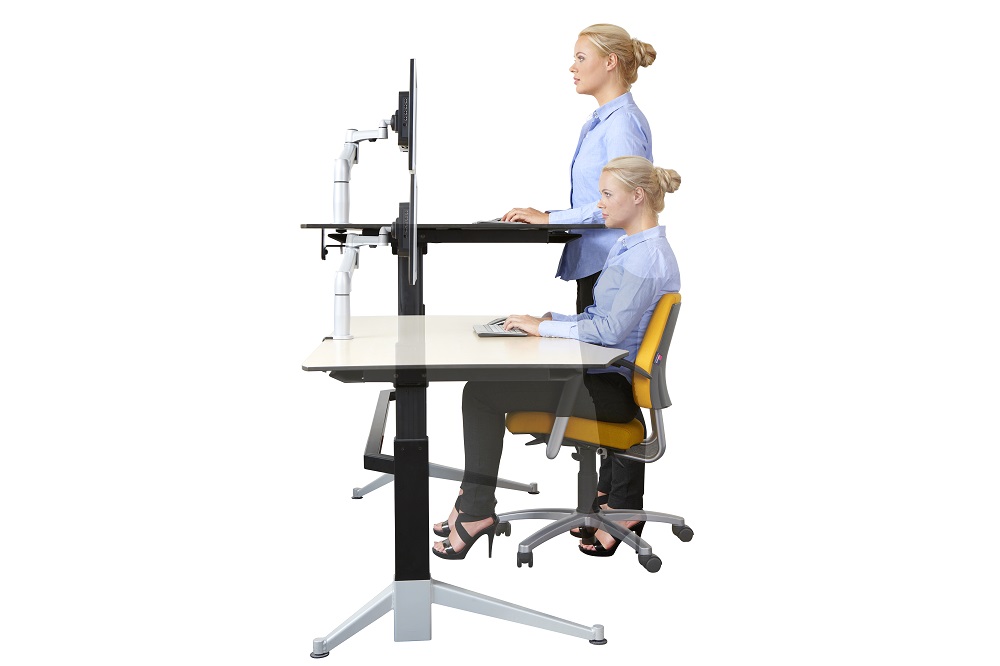Guy Osmond from Osmond Ergonomics gives us his take on the allure of the sit-stand desk phenomena and provides tips for a healthier worklife.
Much has been said and written about sit-stand desks. And much of it has been (and still is) nonsense!
Sit-stand desks have been available in various forms (primarily crank-adjustment, counter-balanced or electric and, more recently, desktop adaptors) for over twenty years. However, it is only within the last few years that they have received so much attention.
Before I continue I should state that I have been selling sit-stand desks for nearly twenty years and wholeheartedly recommend their use. I strongly support their implementation as part of a wider health and productivity regime with proper training and clearly defined purpose. What I question is the way in which many people in the workplace furniture industry have misappropriated the sit-stand desk as some sort of panacea to avoid a range of health conditions and avert early death! In the next few hundred words I hope to explode a few myths and clarify some misunderstandings.
Soon after the research was published, someone recognised that the possible outcomes of prolonged sitting are comparable with those associated with smoking and the expression ‘Sitting is the new smoking’ was born. In the age of social media, 24 hour news and tabloid newspapers, this was, of course, Soundbite Heaven. The expression soon began to appear frequently, often quoted by people who had no idea of the origin, context or the true meaning.
With scare stories appearing in the media, the time was ripe for the publication in 2015 of a Consensus Statement (not a research paper) entitled ‘The sedentary office: a growing case for change towards better health and productivity’. This appeared under the banner of Public Health England and was published on the web site of the British Journal of Sports Medicine. With such apparent credibility, this statement recommended (among other outcomes) ‘standing and light activity’ for between two and four hours per day and that ‘seated-based work should be regularly broken up with standing-based work, the use of sit–stand desks, or the taking of short active standing breaks’.
At the time of publication, there was some controversy about an undeclared conflict of interest because one of the authors also owns a sit-stand desk company. However, nearly 80 news outlets picked up the story and the conflict of interest was lost in the media flurry that followed.
Spawned by these media reports, there have been countless articles, blogs and stories of varying quality and value. Many are sales pitches thinly disguised as advice and many fail to make the fundamental observation that the whole issue is about sitting less, not about standing more.

People like a simple message. It could be tempting to approach the issue as a binary choice between sitting and standing and then try to find a way to quantify that. At a recent conference in the United States, I witnessed several delegates (in various seminars) ask the question ‘how long should we stand for?’ and, of course, the right answer is the classic ergonomist’s response: ‘It depends’. Individuals have very different comfort thresholds for standing. In addition, individual health, fitness, posture, footwear and numerous other factors need to be considered. More important still is the simple fact that sitting and standing do not make the whole equation. Movement is also an essential constituent.
During her many years at NASA, Dr Joan Vernikos concluded that a key element to health is to ensure we trigger our ‘gravity muscles’ frequently. We do this by standing up and doing everyday activities that counter gravity, such as putting things on shelves, using steps and stairs, dancing, carrying the shopping, even gardening. Her research demonstrated that the number of times you counter gravity is more important than how long you do it for. It is therefore important to ensure that you do not sit for too long and you make frequent changes of posture. Getting up every 20-30 minutes is optimal but do not simply swap sitting for standing. Move about and change posture frequently.
To put all this information into context, here are some ideas for individuals and employers to improve the health of individuals and minimise the health risks of sitting at work:
Ideas for individuals to sit less and be more healthy
- Whether you are sitting or standing, ensure your posture is good.
- Do not sit or stand for too long. Mix it up.
- Drink lots of water. It is good for you and creates natural comfort breaks.
- Have some meetings standing.
- Try walking meetings.
- Think about your tasks. Some are better suited to standing.
- Raise your sit-stand desk up too high at the end of the day. It makes life easier for cleaners and forces you to reposition it in the morning.
- Raise the desk when colleagues approach to talk to you and have your conversation standing up.
- Stand for telephone conversations, especially if you need to be assertive. Or walk and talk.
- Stand to sort papers and files.
- Sending an internal email? Go and speak to the person instead.
- Park as far away from the building as possible. Do the same when you go shopping.
- Use the stairs, not the lift.
- Wear a fitness tracker and track your steps. Compete with yourself to improve your average.
- Do stretching exercises at your desk and/or on the move.
- Enrol in health programmes.
Ideas for employers to optimise performance through sit-stand furniture & alternatives to sitting
- Train users to understand how to use their sit-stand desk, when to make posture changes and what good posture feels like (sitting and standing).
- Install “poseur tables” for short standing meetings and touch down use.
- Consider replacing some meeting tables with standing versions.
- Check if it is possible to slow down the lift(s) to encourage stair use.
- In established Hot Desking areas, install a pair of sit-stand desks at the end of each set of standard desks. This will work very well provided good policies and procedures are in place (and the Hot Desking facilities are properly implemented and managed).
- Use schemes like Global Corporate Challenge which both encourage movement and foster team building.
- Create walking routes around your premises.
- Label routes and staircases with calories burned using schemes like StepJockey.
- Incorporate posture and ergonomics into your health and wellbeing programmes.
- Gamify your workplace to encourage movement.
In summary, therefore:
- Sit-stand desks are wonderful but not the sole solution.
- Make sure people are trained how to adopt good sitting and standing postures. Experience tells us that this is not as obvious as it sounds!
- Make frequent changes of posture whilst sitting and get up at least every 20-30 minutes.
- If you do not like standing, make sure you still stand up and sit down at least every 20 minutes.
- Do not just swap sitting for standing.
- Create opportunities to walk and move about during your working day.
- Be critical of what you hear! Is it true or is it just a sales pitch?
Want to ensure your sit-stand desks work for your organisation? Our sit-stand software empowers your employees to make the most out of your investment.
Contact Cardinus today on [email protected] or call 020 7490200



